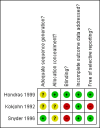Spinal manipulation for primary and secondary dysmenorrhoea
- PMID: 16855988
- PMCID: PMC6718213
- DOI: 10.1002/14651858.CD002119.pub3
Spinal manipulation for primary and secondary dysmenorrhoea
Abstract
Background: Dysmenorrhoea refers to the occurrence of painful menstrual cramps of uterine origin and is a common gynaecological condition. One possible treatment is spinal manipulation therapy. One hypothesis is that mechanical dysfunction in certain vertebrae causes decreases spinal mobility. This could affect the sympathetic nerve supply to the blood vessels supplying the pelvic viscera, leading to dysmenorrhoea as a result of vasoconstriction. Manipulation of these vertebrae increases spinal mobility and may improve pelvic blood supply. Another hypothesis is that dysmenorrhoea is referred pain arising from musculoskeletal structures that share the same pelvic nerve pathways. The character of pain from musculoskeletal dysfunction can be very similar to gynaecological pain as it can present as cyclic pain altered by hormonal influences associated with menstruation.
Objectives: To determine the safety and efficacy of spinal manipulative interventions for the treatment of primary or secondary dysmenorrhoea when compared to each other, placebo, no treatment, or other medical treatment.
Search strategy: We searched the Cochrane Menstrual Disorders and Subfertility Group Trials Register (searched April 2006), CENTRAL (The Cochrane Library 2006, Issue 1), MEDLINE (1966 to March 2006), EMBASE (1980 to April 2006), CINAHL (1982 to March 2006), AMED (1985 to April 2006), Biological Abstracts (1969 to March 2006), PsycINFO (1806 to April 2006), and SPORTDiscus (1830 to April 2006). Attempts were also made to identify trials from the metaRegister of Controlled Trials and the citation lists of review articles and included trials. In most cases the first or corresponding author of each included trial was contacted for additional information.
Selection criteria: Any randomised controlled trials (RCTs) including spinal manipulative interventions (for example chiropractic, osteopathy, or manipulative physiotherapy) versus each other, placebo, no treatment, or other medical treatment were considered. Exclusion criteria were: mild or infrequent dysmenorrhoea or dysmenorrhoea from an intrauterine device (IUD).
Data collection and analysis: Four trials of high velocity, low amplitude manipulation (HVLA), and one of the Toftness manipulation technique were included. Quality assessment and data extraction were performed independently by two review authors. Meta analysis was performed using odds ratios for dichotomous outcomes and weighted mean differences for continuous outcomes. Data unsuitable for meta-analysis were reported as descriptive data and were also included for discussion. The outcome measures were pain relief or pain intensity (dichotomous, visual analogue scales, descriptive) and adverse effects.
Main results: Results from the four trials of high velocity, low amplitude manipulation suggest that the technique was no more effective than sham manipulation for the treatment of dysmenorrhoea, although it was possibly more effective than no treatment. Three of the smaller trials indicated a difference in favour of HVLA, however the one trial with an adequate sample size found no difference between HVLA and sham treatment. There was no difference in adverse effects experienced by participants in the HVLA or sham treatment. The Toftness technique was shown to be more effective than sham treatment by one small trial, but no strong conclusions could be made due to the small size of the trial and other methodological considerations.
Authors' conclusions: Overall there is no evidence to suggest that spinal manipulation is effective in the treatment of primary and secondary dysmenorrhoea. There is no greater risk of adverse effects with spinal manipulation than there is with sham manipulation.
Conflict of interest statement
None known
Figures







Update of
-
Spinal manipulation for primary and secondary dysmenorrhoea.Cochrane Database Syst Rev. 2004;(3):CD002119. doi: 10.1002/14651858.CD002119.pub2. Cochrane Database Syst Rev. 2004. Update in: Cochrane Database Syst Rev. 2006 Jul 19;(3):CD002119. doi: 10.1002/14651858.CD002119.pub3. PMID: 15266463 Updated.
References
References to studies included in this review
-
- Hondras MA, Long CR, Brennan PC. Spinal manipulation therapy versus a low force mimic maneuver for women with primary dysmenorrhea: a randomized, observer‐blinded clinical trial. Pain 1999;81(1‐2):105‐14. - PubMed
-
- Kokjohn K, Schmid DM, Triano JJ, Brennan PC. The effect of spinal manipulation on pain and prostaglandin levels in women with primary dysmenorrhea. Journal of Manipulative and Physiological Therapeutics 1992;15(5):279‐85. - PubMed
-
- Snyder BJ, Sanders GE. Evaluation of the Toftness system of chiropractic adjusting for subjects with chronic back pain, chronic tension headaches, or primary dysmenorrhea. Chiropractic Techniques 1996;8(1):3‐9.
References to studies excluded from this review
-
- Boesler D, Warner M, Alpers A, Finnerty EP, Kilmore MA. Efficacy of high‐velocity low‐amplitude manipulative technique in subjects with low‐back pain during menstrual cramping. Journal of the American Osteopathic Association 1993;93(2):203‐14. - PubMed
-
- Thomason PR, Fisher BL, Carpenter PA, Fike GL. Effectiveness of spinal manipulative therapy in treatment of primary dysmenorrhea: A pilot study. Journal of Manipulative and Physiological Therapeutics 1979;2(3):140‐5.
Additional references
-
- Assendelft WJ, Bouter LM, Knipschild PG. Complications of spinal manipulation: a comprehensive review of the literature. Journal of Family Practice 1996;42(5):475‐80. - PubMed
-
- Astin JA, Marie A, Pelletier KR, Hansen E, Haskell WL. A review of the incorporation of complementary and alternative medicine by mainstream physicians. Archives of Internal Medicine 1998;158(21):2303‐10. - PubMed
-
- Astin JA. Why patients use alternative medicine: Results of a national study. JAMA 1998;279(19):1548‐53. - PubMed
-
- Baker PK. Musculoskeletal origins of chronic pelvic pain: diagnosis and treatment. Obstetrics and Gynecology Clinics of North America 1993;20(4):719‐42. - PubMed
-
- Chesney MA, Tasto DL. The development of the Menstrual Symptom Questionnaire. Behaviour Research and Therapy 1975;13:237‐44. - PubMed
Publication types
MeSH terms
LinkOut - more resources
Full Text Sources
Medical
Miscellaneous

